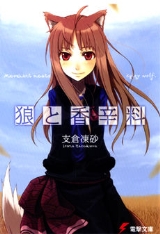
Spice and Wolf
Overview
Light novel
A is a style of Japanese novel primarily targeting junior high and high school students . The term "light novel" is a wasei-eigo, or a Japanese term formed from words in the English language. Light novels are often called or for short...
series written by Isuna Hasekura
Isuna Hasekura
is a Japanese author and student at Rikkyo University. In 2005, Hasekura won the Silver Prize in the twelfth Dengeki Novel Prize with his debut novel Spice and Wolf...
, with illustrations by Jū Ayakura
Ju Ayakura
is a Japanese illustrator primarily of light novels, although he has worked on one video game.-Works:Novels*Hanamori*Ichigoiro Kinku*Imagine Hiseki*Spice and WolfGames*Angel Bullet*Last Bullet-External links:*...
. ASCII Media Works
ASCII Media Works
is a Japanese publishing company in the Kadokawa Group which formed on April 1, 2008 as a result of a merger between ASCII and MediaWorks where MediaWorks legally absorbed ASCII. Despite this, the former president of ASCII, Kiyoshi Takano, became the president of ASCII Media Works. The company...
published 17 novels between February 2006 and July 2011 under their Dengeki Bunko
Dengeki Bunko
is a publishing imprint affiliated with the Japanese publishing company ASCII Media Works . It was established in June 1993 with the publication of Hyōryū Densetsu Crystania volume one, and is a light novel imprint aimed at a male audience...
imprint
Imprint
In the publishing industry, an imprint can mean several different things:* As a piece of bibliographic information about a book, it refers to the name and address of the book's publisher and its date of publication as given at the foot or on the verso of its title page.* It can mean a trade name...
. ASCII Media Works reported that as of October 2008, over 2.2 million copies of the first nine novels have been sold in Japan. The series has been called a "unique fantasy" by Mainichi Shimbun
Mainichi Shimbun
The is one of the major newspapers in Japan, published by .-History:The history of the Mainichi Shimbun begins with founding of two papers during the Meiji period. The Tokyo Nichi Nichi Shimbun was founded first, in 1872. The Mainichi claims that it is the oldest existing Japanese daily newspaper...
due to the plot focusing on economics, trade, and peddling rather than the typical staples of fantasy such as swords and magic.

